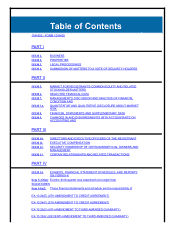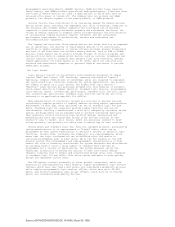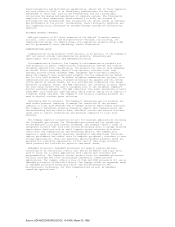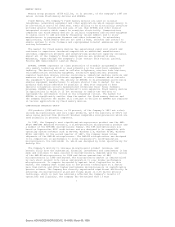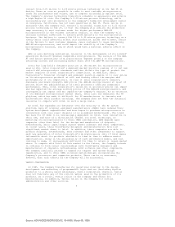AMD 1997 Annual Report Download - page 12
Download and view the complete annual report
Please find page 12 of the 1997 AMD annual report below. You can navigate through the pages in the report by either clicking on the pages listed below, or by using the keyword search tool below to find specific information within the annual report. Vantis products ($243 million, or 10 percent, of the Company's 1997 net
sales) include both complex and simple, high performance CMOS (complimentary-
metal-oxide-semiconductor) programmable logic devices (PLDs).
PLDs are standard products purchased by system manufacturers in an
unprogrammed or "blank" state, which can be programmed by each system
manufacturer to perform a variety of specific logic functions. Certain PLDs,
including the Company's, are reprogrammable, which means that the logic
configuration can be modified after the device is initially programmed, and,
in many cases, while the PLD remains in the end-product system. PLDs are used
by manufacturers of telecommunications and networking systems, computers and
industrial and other electronic systems to reduce product development time and
costs and to improve system performance and reliability.
Vantis has developed a broad product line of low-density and high-density
PLD products, including simple programmable logic devices and complex
programmable logic devices, and recently introduced its new line of field
programmable gate arrays. PLDs are used in complex electronic systems,
including telecommunications and networking systems, high-performance
computers and peripherals, video graphics and imaging systems, and
instrumentation and test systems. PLDs are also used in a variety of consumer
electronic devices, and in medical instrumentation and industrial control
applications.
Customers utilizing programmable logic devices generally use special
software "fitters," usually provided by the suppliers of the programmable
logic devices, that allow electrical circuit designs to be implemented using
complex programmable logic devices. Vantis provides its PLD customers with
software fitters which it licenses from third parties and is dependent upon
third parties for continued development and maintenance of the software. The
Company recently initiated efforts to internally manage and control the
development and maintenance of software fitters for the Company's products. No
assurance can be given that the Company's efforts to internally develop and
maintain the software needed to sell and support its products will be
successful. An inability of Vantis to continue to obtain appropriate software
and improvements from third parties, to license alternative software from
another third party, or to successfully develop and maintain its own software
internally could materially adversely affect Vantis' business, including the
timing of new or improved product introductions, which could have a material
adverse effect on the Company.
RESEARCH AND DEVELOPMENT; MANUFACTURING TECHNOLOGY
The Company's expenses for research and development in 1997, 1996 and 1995
were $468 million, $401 million and $417 million, respectively. Such expenses
represented 20 percent, 21 percent and 17 percent of net sales in 1997, 1996
and 1995, respectively. The Company's research and development expenses are
charged to operations as incurred. Most of the Company's research and
development personnel are integrated into the engineering staff.
Manufacturing technology is the key determinant in the improvement in
semiconductor products. Each new generation of process technology has resulted
in products with higher speeds and greater performance produced at lower cost.
AMD continues to make significant infrastructure investments to enable the
Company to continue to achieve high volume, high reliability and low cost
production using leading edge process technology.
The Company's efforts concerning process technologies are focused in three
major areas: non-volatile memory technology used by Flash memory and EPROM
products; logic technology used by the Company's microprocessors, embedded
processors, I/O, networking and communications products; and programmable
logic technology used in the Vantis programmable logic products. The Company's
goals are to increase density and improve product performance, to reduce the
access time for non-volatile memory products and to increase the clock speed
for microprocessor products.
In order to remain competitive, the Company must make continuing substantial
investments in improving its process technologies. In particular, the Company
has made and continues to make significant research and development
investments in the technologies and equipment used in the fabrication of its
microprocessor
9
Source: ADVANCED MICRO DEVIC, 10-K405, March 03, 1998


